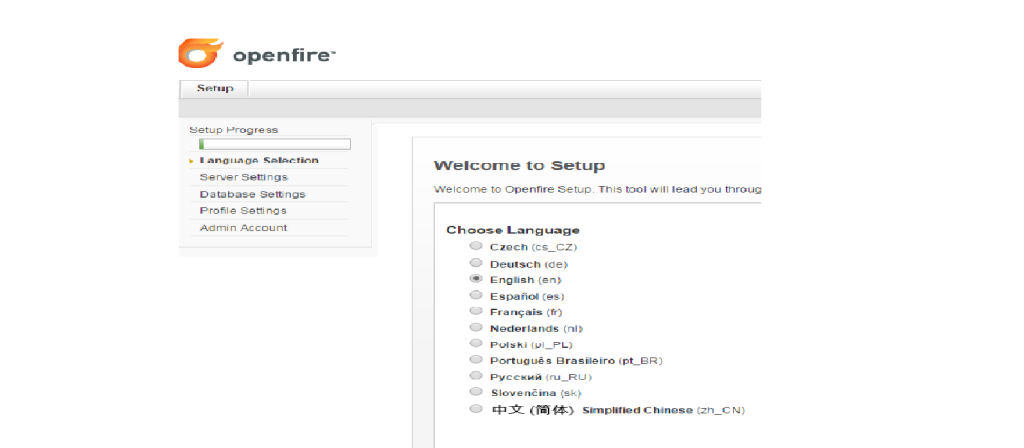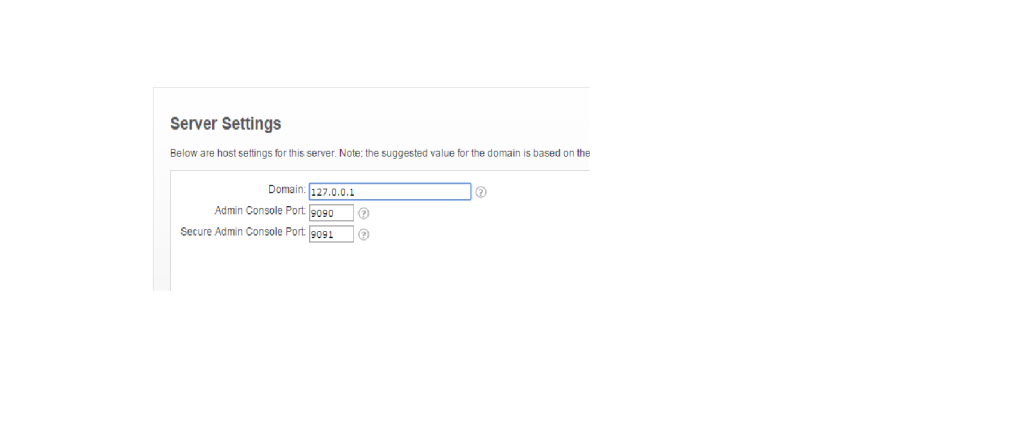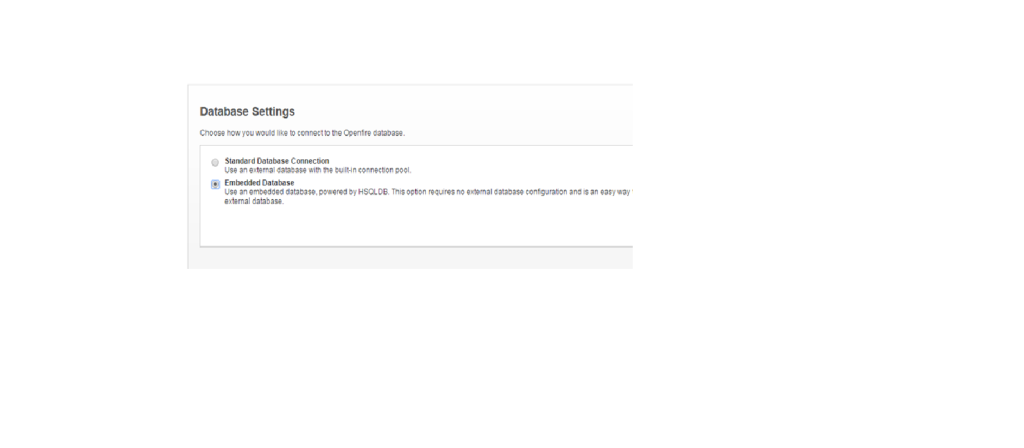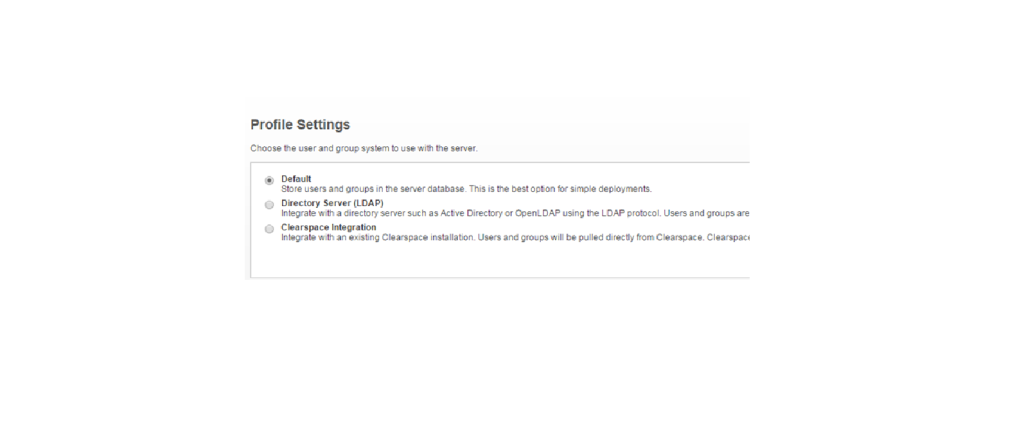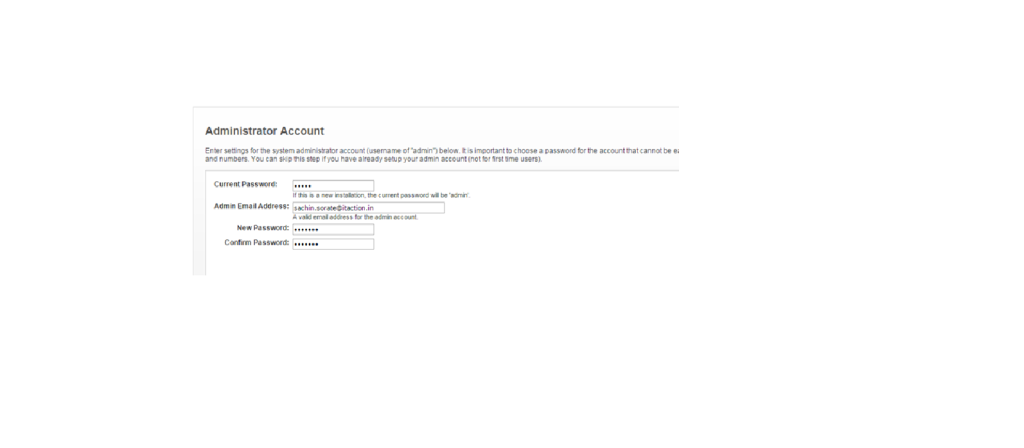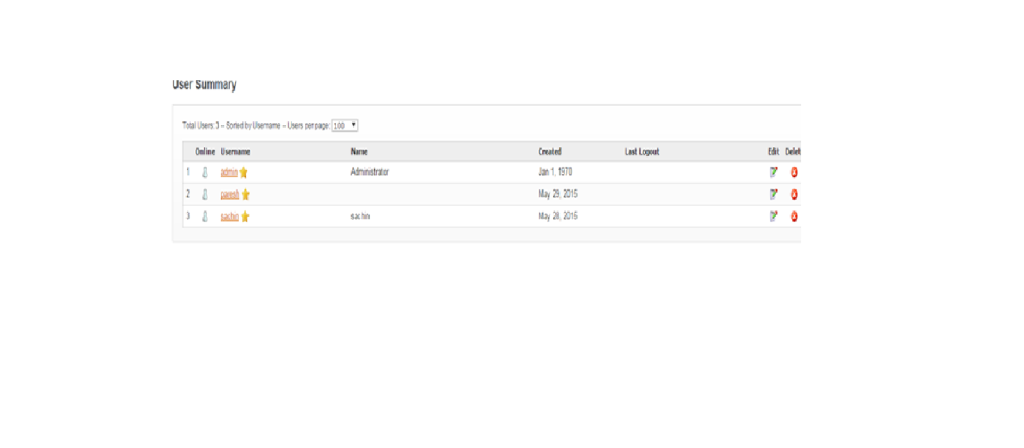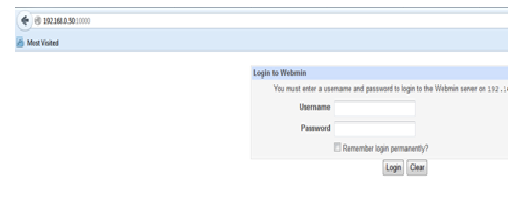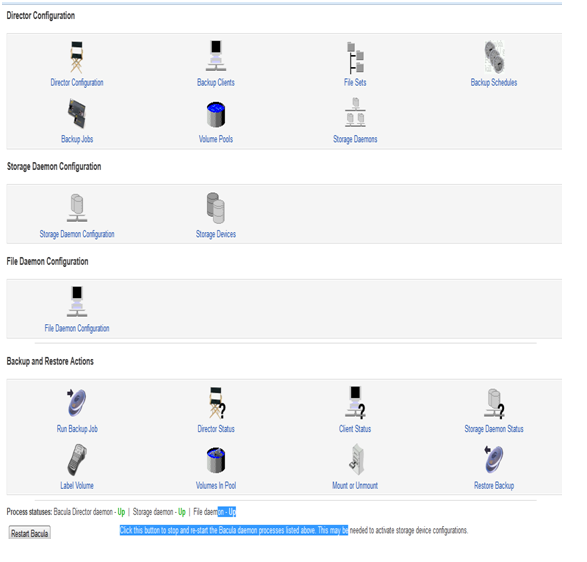SharePoint : Redirect to different home page for authenticated users
Hi All,
Today I got a requirement where authenticated users should be redirected to a different page, here is how I achieved it.
Editing the exiting SharePoint Landing page, then add a new content editor Web Part on the page. Now edit the content editor webpart and click on Web part properties on top. Now select “Embed code” under Insert for content editor webpart, add below script in :
<meta http-equiv=”refresh” content=”5;url=http://sharepoint/SitePages/Home.aspx”>
Try to check if your site is redirect to the new site.
If the redirection is working fine then we will restrict this script only for authenticated users. We need to edit the page again and select Edit webpart. Under Advance setting Set Target Audience as “NT Authenticated users”
Hope this helps you.
openfire installation on Centos 6.6
Hello Everyone,
Today we are installing openfire server on centos
what is openfire is opensource IM server means it’s best alternative for MS lync, you can also enable voice chat in openfire for that you have to install require plug inns.
& again best things for openfire is it’s FREE….
So here we start openfire installation
Login to the server as root This installs the dependencies:
yum -y install wget java glibc.i686
download RPM from
wget http://download.igniterealtime.org/openfire/openfire-3.8.1-1.i386.rpm
Run & installed the RPM
Yum –y install openfire-3.8.1-1.i386.rpm
Now start the openfire service
service openfire start
chkconfig openfire on
now stop the iptable for time being
service iptables stop
Install mysql server
yum -y install mysql-server
now start the mysql service
service mysqld start
chkconfig mysqld on
mysql secure installation
mysql_secure_installation
NOTE: RUNNING ALL PARTS OF THIS SCRIPT IS RECOMMENDED FOR ALL MySQL
SERVERS IN PRODUCTION — USE! PLEASE READ EACH STEP CAREFULLY!
In order to log into MySQL to secure it, we’ll need the current
password for the root user. If you’ve just installed MySQL, and
you haven’t set the root password yet, the password will be blank,
so you should just press enter here.
Enter current password for root (enter for none):
OK, successfully used password, moving on…
Setting the root password ensures that nobody can log into the MySQL
root user without the proper authorisation.
Set root password? [Y/n] y
New password:
Re-enter new password:
Password updated successfully!
Reloading privilege tables..
… Success! ………………………………………………………………………………………………………………………………………..
……………………………………………………………………………………………………………………………………………………………..
…………………………………………………………………………………………………………………………………………………………………………….
Now Restart mysql server
service mysqld restart
Now log in to the mysql with root username & password , create a database named “openfire”
mysql -u root –p
create a database openfire
mysql> — CREATE DATABASE openfire;
mysql> CREATE — USER ‘fire’@’localhost’ IDENTIFIED BY ‘root123’;
Query OK, 0 rows affected (0.00 sec)
mysql> GRANT SELECT,INSERT,UPDATE,DELETE,CREATE,DROP
-> ON openfire.*
-> TO ‘fire’@’localhost’;
Query OK, 0 rows affected (0.00 sec)
mysql> FLUSH PRIVILEGES;
Query OK, 0 rows affected (0.00 sec)
mysql>exit
Service iptables stop
Or
You can add below ports in iptables
-A INPUT -m state –state NEW -m tcp -p tcp –dport 9090 -j ACCEPT
-A INPUT -m state –state NEW -m tcp -p tcp –dport 5222 -j ACCEPT
-A INPUT -m state –state NEW -m tcp -p tcp –dport 5223 -j ACCEPT
-A INPUT -m state –state NEW -m tcp -p tcp –dport 9091 -j ACCEPT
-A INPUT -m state –state NEW -m tcp -p tcp –dport 7777 -j ACCEPT
-A INPUT -m state –state NEW -m tcp -p tcp –dport 7070 -j ACCEPT
-A INPUT -m state –state NEW -m tcp -p tcp –dport 7443 -j ACCEPT
-A INPUT -m state –state NEW -m tcp -p tcp –dport 5229 -j ACCEPT
-A INPUT -j REJECT –reject-with icmp-host-prohibited
[root@openfire ~]# service iptables restart
iptables: Setting chains to policy ACCEPT: filter [ OK ]
iptables: Flushing firewall rules: [ OK ]
iptables: Unloading modules: [ OK ]
iptables: Applying firewall rules: [ OK ]
http://hostname:9090/login.jsp
log in to the server as
admin
default password “admin”
I have created user named “Sachin” & “paresh”
Install Spark messenger on your desktop
Downlod link for spark IM
http://www.igniterealtime.org/downloads/
It’s
Done
–Sachin
What’s new in SharePoint server 2016 deployment
Hi All,
Let’s talk about SharePoint 2016 newly release deployment details.
We will start with Hardware requirements, we can see that SharePoint 2016 would require something between 8 to 16 GB of RAM but for 1st time ever Microsoft has suggested a secondary drive on all SharePoint and SQL servers. Suggested minimum number of processor is 4 cores which mean we will have minimum I5 on all servers.
List of Unsupported Deployment Scenarios make a big difference for SharePoint 2016. Workgroup, Client OS (Windows 7, Vista, etc), Dynamic Memory and Windows Web Server would be unsupported. So you would need a Domain environment with windows server and Static RAM on all servers. This will increase license cost and hardware cost because an additional AD server and memory would be required.
So far Windows server 2012 R2 and Technical preview are supported OS.
Although .net framework 4.6 is released, you would need minimum .net framework 4.5.2 to install SharePoint server 2016.
There is no much change for Prerequisites of SharePoint server 2016:
Application Server Role
Web Server (IIS) Role
Microsoft SQL Server 2012 Native Client
Microsoft ODBC Driver 11 for SQL Server
Microsoft Sync Framework Runtime v1.0 SP1 (x64)
Windows Server AppFabric 1.1
Cumulative Update Package 1 for Microsoft AppFabric 1.1 for Windows Server (KB2671763)
Microsoft Identity Extensions
Microsoft Information Protection and Control Client
Microsoft WCF Data Services 5.0
Microsoft WCF Data Services 5.6
Microsoft .NET Framework 4.5.2
Update for Microsoft .NET Framework to disable RC4 in Transport Layer Security (KB2898850)
Visual C++ Redistributable Package for Visual Studio 2013
You would need SQL server 2014 to install SharePoint 2016 in your environment.
I don’t know why we still use AppFabric when we know it will be discounted soon in 2016. As you can see “Microsoft Information Protection and Control Client” is the only new Prerequisite and it will be used for compliance on SharePoint server. We can see the same on Central Admin screen.

Now comes the most interesting part of SharePoint 2016 which is MinRole. During MVP summit 2014 we were told about Minrole and its database. Had a big conversation on same because it may have complexity with upgrade but here I see that Minrole is implemented in SharePoint 2016.
Now the services will be divided in 3 sections viz User services, Robot services and caching services. Now when you install SharePoint 2016, you would get option to select role you wish to enable on the SharePoint server. Previously we had Single Server or Application and WFE role but now we have 6 different roles available with us viz SpecialLoad, WebFrontEnd, SingleServerFarm, Search, Application, DistributedCache.
Here is the secret of these roles, predefined server role is configured and optimized for its intended purpose provisioning the expected services designed to support its function within a server farm environment. So you don’t have to worry about which server should run which services.
You can configure SharePoint 2016 using psconfig GUI or powershell. As far as I know stsadm command are now deprecated and cannot be used in SharePoint 2016 for management or configuration purpose.
To configure a SharePoint farm we need to use below powershell command:
psconfig.exe -cmd configdb -create –server “SQLserver” –database “wss_config” –user “itfreesupport\inder” –password “123456” –passphrase “pass_phase1” –admincontentdatabase “admin_contentdb” -localserverrole “Application”
Here is a GUI interface of a SharePoint 2016 psconfig wizard.
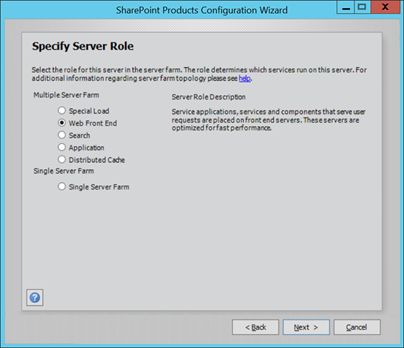
Another advantage of these MinRole is related to Server Health rules. If you have selected SharePoint search role and health rule detects any other service running on the server, it will give you an alert for same. Now this is what I say a new feature in SharePoint 2016.
Now comes the biggest pain with SharePoint 2016. You cannot perform a SharePoint 2016 inplace upgrade. This means you will have to create\reconfigure your Service application and use attach detach method to complete your upgrade. Another problem is we need upgrade to SharePoint 2013 and then we can upgrade to SharePoint 2016. A direct upgrade from older version of SharePoint is not available in SharePoint server 2016.
Reference : What’s new in SharePoint Server 2016 Installation and Deployment
What is a Site Collection in SharePoint?
There are lot of confusions between Site Collection, sites and web application so though I will try to put some light on same. A very high level overview of a Site Collection is that Site collection share common features like Content types, Templates, Site columns, permissions, Web Parts etc. In other words a site collection groups together websites, and (perhaps most importantly) the security data for these websites. A site Collection stores references to a bunch of information critical to any web site. This information includes, but is not limited to:
–Web Parts
–Users which have access to the website
–Themes
–Sandbox Solutions
–MasterPages
–List Templates
Site Collection facilitates better administration of our internet\intranet websites. Let me explain using an example. We have a company’s intranet site and that intranet site (http://intranet) has multiple departments based sub sites like Finance, Sales, Support, etc. If I need to check something related to Finance, I can simply go to http://intranet/finance and try to find my relevant information in through Shared Document library, Blogging and much more. I would have access to all commonly used information\documents through a single intranet URL.
To the Site Collection all the websites within it are in a flat hierarchy which developers can see using spsite.allwebs or using dbo.allwebs table in content database.
Normally each web application has at least 1 Site Collection but it can have many however every web application has only 1 Top Level Site collection. General setting like Recycle bin and Quotas are organized at site collection level. Most important is each site collection can only use a single content database though multiple site collections can us the same content database.
Sites and subsites in a web application are actual place where content is stored. A site can be a top-level site or a sub site of the top level site. Not to confuse you but even a Sub sites can have other sub sites and so on. It is a free like structure. A site can inherit its parent’s permissions or define its own.
Microsoft recommended limiting the number of site collections in a content database to 5,000. However, up to 10,000 site collections in a database are supported. Microsoft decided this parameter after analyzing speed of upgrade, SharePoint performance, etc. The larger the number of site collections in a database, the slower the upgrade with respect to both database upgrade and site collection upgrades.
Exceeding the 5,000 site collection limit puts you at risk of longer downtimes during upgrades. If you plan to exceed 5,000 site collections, Microsoft recommend that you have a clear upgrade strategy to address outage length and operations impact, and obtain additional hardware to speed up the software updates and upgrades that affect databases.
The maximum recommended number of site collections per SharePoint farm is 500,000 Personal Sites plus 250,000 for all other site templates.
You can create a very large total number of web sites by nesting subsites. For example, in a shallow hierarchy with 100 sites, each with 1,000 subsites, you would have a total of 100,000 web sites. Or a deep hierarchy with 100 sites, each with 10 subsite levels would also contain a total of 100,000 web sites.
Note: Deleting or creating a site or subsite can significantly affect a site’s availability. Access to the site and subsites will be limited while the site is being deleted. Attempting to create many subsites at the same time may also fail.
Microsoft recommends a limiting of 200 GB for each site collections. This 200 gb includes RBS blob files on SQL server.
How we create a site collection?
Open Central Admin > Application management > Create Site Collection > Select the URL and fill in other details > Click OK.
You can also use below Powershell command:
New-SPSite -URL https://itfreesupport.com -OwnerAlias [email protected] -template “STS#0”
How to create a subsite?
Browse your site collection > Select setting button on right top corner > select “site contents” > select new subsite > Provide the URL and fill in other details > click OK.
You can also use below Powershell command:
New-SPWeb http://itfreesupport/subweb1 -Template “STS#0”
Note: Site collection can only be create from Central admin or SharePoint server where as subsite can be created from any machine using site collection URL
Hope this was helpful
What are types of SharePoint installation? what is difference between Farm and standalone?
A very common answer to 1st question is, we have Standalone and Farm installation but when it comes to SharePoint 2010 and SharePoint 2013 I say we have Standalone and complete installation. Why I said “complete” is because when we install Complete edition of SharePoint 2010\2013 we get option to create farm where as in SharePoint 2007, you get option to select Farm or Standalone while we are installing SharePoint. So the trick here is people mention “complete” instead of “Farm” for better understanding.
At first glance, standalone installations seems best for development purposes. The benefits appear to be:
1. Standalone will automatically install SQL Express for you(No SQL server installation needed)
2. Standalone will install using local accounts(no domain controller needed)
In my view a SharePoint standalone setup should be sufficient for development unless you are developing against SharePoint Enterprise only features.(I assume SharePoint foundation or Standard). SharePoint developer save a TON of hassle by having Visual Studio and SharePoint installed on the same OS (e.g. F5 to compile, run and debug all in one go) rather than using separate servers (VM or otherwise) and performing the incantations required to get remote debugging working.
Lots of sites say you need to setup your Development environment with Windows server 2008 but that’s not necessary as Windows 7 (x64 with SharePoint 2010 and SharePoint 2013) or even Windows Vista(with SharePoint 2010) can be used as Development environment.
But I would like to add that a stand-alone environment is sufficient for a development environment, however I would recommend to mimic a stand-alone by choosing a farm installation. You can install a higher version of SQL server(e.g. SQL server 2014 with advance features or SQL server developer edition) for better advantage. Not everyone know what SQL server. No everyone know but regardless of how many physical CPUs you have on your SQL server and how many cores per physical CPU, each SQL Express instance will be limited to a single CPU core. A similar cap is applied to amount of RAM which can be used by SQL server Express edition.
Standalone installation have their own disadvantage like limitations of 4 GB SQL database. connection to SQL from a remove machine, need to separately install Management studio, etc. Moreover if any of your project needs to test a multi-server setup, you cannot mimic the same on a Standalone installation.
On the other hand a farm\complete installation allows you to add other servers and SQL a different SQL server so as to keep you running out of resources. You can install SQL server on a different machine with good resources and allow all your team member to connect to single SQL server for development purpose. SQL server can also be a Active Directory server as it consumes very less resources.
Couple of more differences between SharePoint Farm and SharePoint standalone are:
1. Using separate account to connect to SQL server\SharePoint server
2. Using other accounts to manage a lot of services such as: Excel service, Performance Point, setup reverse proxy, setup load balancing.
3. Allow multiple SharePoint servers join into this farm to improve availability.
4. Multiple SharePoint servers can host Central Administration, Search Index, Search query, Web Application, etc for better performance.
Hope this was helpful
What is a Web Application in SharePoint?
Web Applications are one of the very important and bit what confusing topic in SharePoint. Let me try to simplify the same. If you have worked on IIS, we create IIS site which are the actual URL of IIS site. You specify hostheader and port number while creating a IIS site. We then use the same URL with port number to browse our IIS site(e.g. https://itfreesupport.com:8081 or http://computername:80). We create a Web Application from SharePoint central admin which creates sites in IIS so we can say that SharePoint Web Applications are IIS sites but managed and created from SharePoint Central Admin.
Each Web Application created in SharePoint central admin is associated with a IIS site. We cannot have multiple web Application for one IIS site but we can create upto 5 IIS sites for one Web application(using Extend Web Application feature). This means we can browse same content from different URL’s using different IIS sites\web.config files.
Microsoft support upto 20 Web Application in a SharePoint farm but we can create more then 20 Web applications.
Every Web Application will have minimum 1 content database but there is not hard core limit of databases a Web Application can have. Microsoft supports upto 500 content databases in a SharePoint farm so technically you can have upto 500 content databases for single web application.
On your SharePoint server under services on server, if you have “Microsoft SharePoint Foundation web Application” service running\started, it states this server a WFE(Web front end) server. End users will access your SharePoint sites and services through these WFE servers.
Another very important feature of Web Application is authentication method for SharePoint site. We set authentication method\type(Claims authentication, NTLM authentication, Anonymous authentication, etc) at Web Application level. As discussed already you can have 5 IIS site(extended web application) for a single web application which means you can have 5 different types of authentication for same web application.
We can create Web Application using Powershell, command prompt(cmd) or through SharePoint Central Admin.
To create a new Web Application through powershell using powershell command:
$ap = New-SPAuthenticationProvider
New-SPWebApplication -Name “Itfreesupport” -Port 80 -HostHeader “itfreesupport.com” -URL “https://itfreesupport.com” -ApplicationPool “AppPool” -ApplicationPoolAccount (Get-SPManagedAccount “domain\user”) -AuthenticationProvider $ap
To create a new Web Application through stsadm command follow below:
stsadm -o extendvs -url https://itfreesupport.com -ownerlogin domain\user -owneremail “[email protected]”
To create a new Web Application through central admin follow below:
Open SharePoint Central Admin > Select “Application management” > Select “Manage Web Application” > Select “New” on top ribbon > Complete the details e.g. port number, host header url, etc and click OK
Hope this was helpful
SharePoint 2010 \ 2013: Search Service Application stopped working
Hi Friends,
Today search stopped working on an a server. Found that search service was stopped on Central Admin > “Services on server” tab.
When try to start it get error “starting the search service on a server much be done within the context of a search service application. click ok to go to the manage service application spage where you can create a new search service application or select a search servicea application”
There was no option to stop or start anything from Search Service Application.
Tried to open Search Service Application using run as admin for browser. Also tried using multiple browser but it did not help.
When tried to delete and recreate service application, got below error while deleting service application.
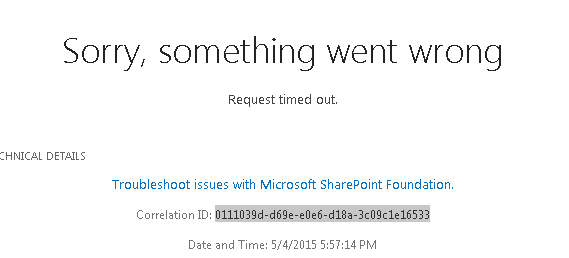
When checked ULS logs got error:
Application error when access /_admin/ServiceApplicationDelete.aspx, Error=Request timed out.
System.Web.HttpException: Request timed out.
Getting Error Message for Exception System.Web.HttpException (0x80004005): Request timed out.
Then I tried to delete the service application using powershell. Used below powershell for same.
$spapp = Get-SPServiceApplication -Name “Search Service Application”
Remove-SPServiceApplication $spapp -RemoveData
Incase you don’t see a outcome for a long time, open another SharePoint powershell windows without closing this and run below command:
stsadm -o execadmsvcjobs
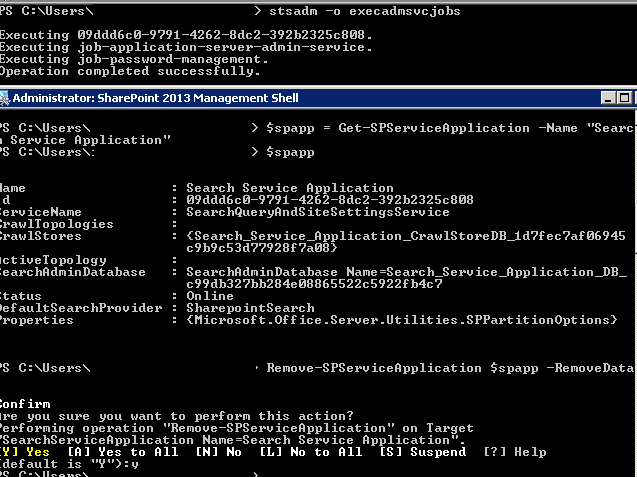
Once the service application is deleted, follow below steps to create a new search service application using GUI.
Open Central Admin > Select “Configuration Wizards” from left hand side > Select “Launch the Farm Configuration Wizard” > Click “Start the Wizard” > Make sure “Search Service Application” is selected > Click Continue
Shortly your search service application would be created and ready to use.
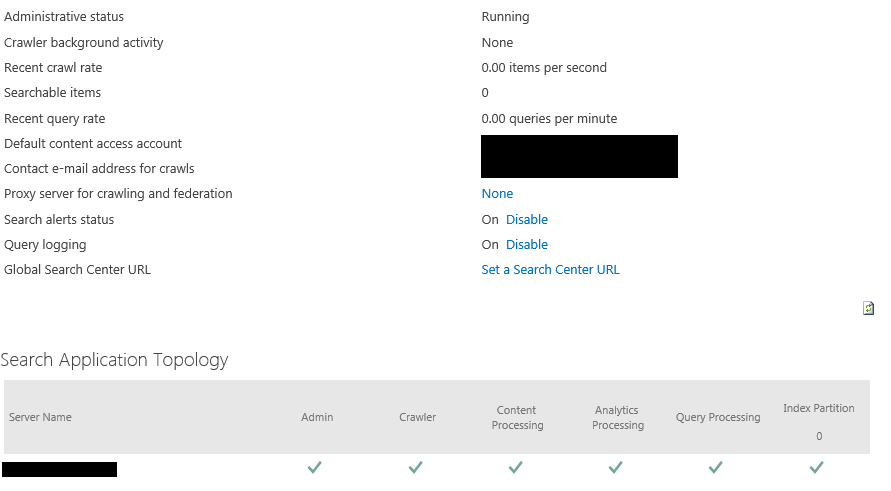
Applies to : SharePoint server 2013, SharePoint server 2010, SharePoint foundation 2010, SharePoint foundation 2013.
Caching in MVC 5 Asp.net
Hello Everyone,
In this blog I want to share advantages of caching in MVC. Its a very important to know how caching is used in MVC websites.
By using Caching, we can store content at client’s browser and/or server. We can easily access these data and content when required.Caching data or content provides following advantages:
- Minimize Request To Hosting Server
- Minimize Request To Database Server
- Reduce Network Traffic
- Save Time and resources
- Above advantages helps in improving the performance of MVC Website.
There are two types of method for caching available in MVC.
- Page Output Caching
- Application Caching
In this blog we will discuss on Page Output Caching.We can achieve this by
adding OutputCache attribute to either an individual controller action or an
entire controller class.
OutputCache Filter Parameter :
| Parameter | Type | Description |
|---|---|---|
| CacheProfile | string | It is the name of the output cache profile which is defined with in tag of Web.config. |
Example: Creating Cache profile in cache.
<caching>
<outputCacheSettings>
<outputCacheProfiles>
<add name=”Test1″ duration=”30″ varyByParam=”none”/>
</outputCacheProfiles>
</outputCacheSettings>
</caching>
And this cache profile is used in the action method as shown below.
[OutputCache(CacheProfile = “Test1”)]
public ActionResult Index()
{
return View();
}
| Parameter | Type | Description |
|---|---|---|
| Duration | int | It specify the duration in sec to cache the content. |
Example : The output of the Index() action is cached for 30 seconds.
using System.Web.Mvc;
namespace MvcApplication1.Controllers
{
public class HomeController : Controller
{
[OutputCache(Duration=30, VaryByParam=”none”)]
public ActionResult Index()
{
return View();
}
}
}
Note: If you will not defined the duration, it will cached it for
by default cache duration 60 sec.
| Parameter | Type | Description |
|---|---|---|
| Location | OutputCacheLocation | It specify the location of the output to be cached. Location property can be any one of the following values:
|
Example: Cache stored at client browser.
using System.Web.Mvc;
using System.Web.UI;
namespace MvcApplication1.Controllers
{
public class UserController : Controller
{
[OutputCache(Duration=3600, VaryByParam=”none”, Location=OutputCacheLocation.Client)]
public ActionResult Index()
{
return View();
}
}
}
| Parameter | Type | Description |
|---|---|---|
| VaryByParam | string | This property enables us to create different cached versions of the very same content when a form parameter or query string parameter varies. If not specified, the default value is none. VaryByParam=”none” specifies that caching doesn’t depend on anything. |
| VaryByCustom | string | This is used for custom output cache requirements |
| VaryByHeader | string | This specify list of HTTP header names that are used tovary the cache content. |
Example:
public class TestController : Controller
{
[OutputCache(Duration = 30, VaryByParam = “none”)]
public ActionResult Index()
{
return View();
}
[OutputCache(Duration = 30, VaryByParam = “id”)]
public ActionResult Index1()
{
return View();
}
}
| Parameter | Type | Description |
|---|---|---|
| NoStore | bool | It enable/disable where to use HTTP Cache-Control. This is used only to protect very sensitive data. |
| SqlDependency | string | It specify the database and table name pairs on which the cache content depends on. The cached data will expire automatically when the data changes in the database. |
For more information visit here
I hope this will help you.Your valuable feedback and comments are important for me.
Connect to On Premises SharePoint 2013 site using Powershell on your local computer
Hi Friends,
Recently I had a word with Ryan Yates on our yammer group and found a interesting Powershell script. Ryan created a powershell script named “Client-side SharePoint PowerShell”is avaiable on Codeplex https://sharepointpowershell.codeplex.com. We can use this script to connect to on-premises SharePoint site using Powershell and execute queries on same. I found it pretty intreseting so I tried same. Below are couple of requirement to use this powershell script.
- Windows powershell 3.0
- Copy 15 folder from any sharepoint server(path C:\Program Files\Common Files\microsoft shared\Web Server Extensions) to local client machine at same location.
- Client user have atleast read permission on target URL.
- Client system should be part of same domain.
If above requirement are met, lets get connect to remote SharePoint server. We need to download “Client-side SharePoint PowerShell” from codeplex site and extract it to a folder(e.g. c:\inder). Then Open Windows Powershell(Run as Admin) and browse(cd C:\Inder\sharepointpowershell-42493) to Powershell folder as shown below:
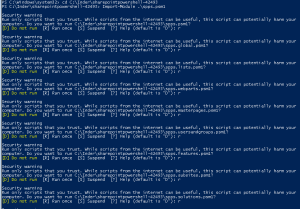
- Now we We need to load “Client-side SharePoint PowerShell” module using “Import-Module .\spps.psm1” command

Note: You might have to select “R” multiple times to load all the scripts -
Finally we need to connect to SharePoint site using command “Initialize-SPPS -siteURL http://siteurl”

-
If we dont see any error message, it means our SharePoint is now conenct and ready to use.
Below are arguments you can use in this powershell
Upload Sandboxed WSP to the site
Add-Solution -path “$exampledir\Solutions\solution.wsp”
Activate the WSP
Install-Solution -solutionName “AESBTwitterWebpart.wsp”
Create a subsite
Add-Subsite -title “Subsite” -webTemplate “STS#0” -description “Description…” -url “subsite” -language 1033 -useSamePermissionsAsParentSite $true
Go to the subsite
Open-Subsite -relativeUrl “/subsite”
Enable the publishing feature
Enable-Feature -featureId “94c94ca6-b32f-4da9-a9e3-1f3d343d7ecb” -force $false -featureDefinitionScope “Web”
Create document library on the subsite
Add-DocumentLibrary -listTitle “Testdoclib”
Copy testfiles to this document library
Copy-Folder “$exampledir\Subsite\Testdoclib” “Testdoclib” $false
Go back to the root site
Open-Rootsite
copy contents of local folders to SharePoint
$stylelibdir = “$exampledir\Style Library”
$styleliburl = “/Style Library”
Set master page
$masterFile = “seattle_custom.master”
Set-CustomMasterPage $masterFile
Create news list
$newsListName = “News”
$newsItemsCSV = “$exampledir\News\items.csv”
Add news web part to the page
Add-Webpart “/Pages/default.aspx” “Header” 0 $webpartXml
Create SharePoint Groups
Add-Group -name “Example Group”
#roleTypes are Guest, Reader, Contributor, WebDesigner, Administrator, Editor
Web
Set-WebPermissions -groupname “Example Group” -roleType “Reader”
Pages lib
Set-ListPermissions -groupname “Example Group” -listname “Pages” -roleType “Reader”
News list
Set-ListPermissions -groupname “Example Group” -listname “News” -roleType “Reader”
Hope this will help you all and help you save time.
Note: If you get error while loading the SharePoint site, make sure you have properly copied 15 hive folder and you are running Windows powershell as admin
You can also check below article written by Ryan Yates himself:
http://www.kilasuit.org/Blog/Post/6/Getting-up-and-Running-with-SPPS-for-PowerShell-and-SharePoint-Usage
Installing Bacula (Enterprise Backup System) With Webmin
Hello Everyone,
Today we are installing the “Bacula”, Bacula is the Enterprise Backup solution & more IMP it’s free.
“Bacula is an open source, enterprise level computer backup system for heterogeneous networks. It is designed to automate backup tasks that had often required intervention from a systems administrator or computer operator.
Bacula supports Linux, UNIX, Windows, and Mac OS X backup clients, and a range of professional backup devices including tape libraries. Administrators and operators can configure the system via a command line console, GUI or web interface; its back-end is a catalog of information stored by MySQL, PostgreSQL, or SQLite.”
–Source WIKI
Currently i am taking backup of more than 1.5TB data on my auto-loader
Let’s start Bacula installation
Installing bacula & mysql all together
yum install bacula-director-mysql bacula-console bacula-client bacula-storage-mysql mysql-server mysql-devel –y
[root@Bacula ~]# yum install bacula-director-mysql bacula-console bacula-client bacula-storage-mysql mysql-server mysql-devel -y
Loaded plugins: fastestmirror
Setting up Install Process
base | 3.7 kB 00:00
base/primary_db | 4.6 MB 00:29
extras | 3.4 kB 00:00
extras/primary_db | 30 kB 00:00
updates | 3.4 kB 00:00
updates/primary_db | 2.8 MB 00:13
Resolving Dependencies
–> Running transaction check
—> Package bacula-client.x86_64 0:5.0.0-12.el6 will be installed
–> Processing Dependency: bacula-common = 5.0.0-12.el6 for package: bacula-client-5.0.0-12.el6.x86_64
—> Package bacula-console.x86_64 0:5.0.0-12.el6 will be installed
—> Package bacula-director-mysql.x86_64 0:5.0.0-12.el6 will be installed
–> Processing Dependency: bacula-director-common = 5.0.0-12.el6 for package: bacula-director-mysql-5.0.0-12.el6.x 86_64
—> Package bacula-storage-mysql.x86_64 0:5.0.0-12.el6 will be installed
–> Processing Dependency: bacula-storage-common = 5.0.0-12.el6 for package: bacula-storage-mysql-5.0.0-12.el6.x86 _64
—> Package mysql-devel.x86_64 0:5.1.73-3.el6_5 will be installed
–> Processing Dependency: mysql = 5.1.73-3.el6_5 for package: mysql-devel-5.1.73-3.el6_5.x86_64
–> Processing Dependency: openssl-devel for package: mysql-devel-5.1.73-3.el6_5.x86_64
—> Package mysql-server.x86_64 0:5.1.73-3.el6_5 will be installed
–> Processing Dependency: perl-DBI for package: mysql-server-5.1.73-3.el6_5.x86_64
–> Processing Dependency: perl-DBD-MySQL for package: mysql-server-5.1.73-3.el6_5.x86_64
–> Processing Dependency: perl(vars) for package: mysql-server-5.1.73-3.el6_5.x86_64
–> Processing Dependency: perl(strict) for package: mysql-server-5.1.73-3.el6_5.x86_64
–> Processing Dependency: perl(Sys::Hostname) for package: mysql-server-5.1.73-3.el6_5.x86_64
–> Processing Dependency: perl(POSIX) for package: mysql-server-5.1.73-3.el6_5.x86_64
–> Processing Dependency: perl(Getopt::Long) for package: mysql-server-5.1.73-3.el6_5.x86_64
–> Processing Dependency: perl(File::Temp) for package: mysql-server-5.1.73-3.el6_5.x86_64
–> Processing Dependency: perl(File::Path) for package: mysql-server-5.1.73-3.el6_5.x86_64
–> Processing Dependency: perl(File::Copy) for package: mysql-server-5.1.73-3.el6_5.x86_64
–> Processing Dependency: perl(File::Basename) for package: mysql-server-5.1.73-3.el6_5.x86_64
–> Processing Dependency: perl(Data::Dumper) for package: mysql-server-5.1.73-3.el6_5.x86_64
–> Processing Dependency: perl(DBI) for package: mysql-server-5.1.73-3.el6_5.x86_64
–> Processing Dependency: /usr/bin/perl for package: mysql-server-5.1.73-3.el6_5.x86_64
–> Running transaction check
—> Package bacula-common.x86_64 0:5.0.0-12.el6 will be installed
—> Package bacula-director-common.x86_64 0:5.0.0-12.el6 will be installed
–> Processing Dependency: perl(Logwatch) for package: bacula-director-common-5.0.0-12.el6.x86_64
–> Processing Dependency: logwatch for package: bacula-director-common-5.0.0-12.el6.x86_64
—> Package bacula-storage-common.x86_64 0:5.0.0-12.el6 will be installed
—> Package mysql.x86_64 0:5.1.73-3.el6_5 will be installed
—> Package openssl-devel.x86_64 0:1.0.1e-30.el6.8 will be installed
–> Processing Dependency: openssl = 1.0.1e-30.el6.8 for package: openssl-devel-1.0.1e-30.el6.8.x86_64
–> Processing Dependency: zlib-devel for package: openssl-devel-1.0.1e-30.el6.8.x86_64
–> Processing Dependency: krb5-devel for package: openssl-devel-1.0.1e-30.el6.8.x86_64
—> Package perl.x86_64 4:5.10.1-136.el6_6.1 will be installed
–> Processing Dependency: perl-libs = 4:5.10.1-136.el6_6.1 for package: 4:perl-5.10.1-136.el6_6.1.x86_64
–> Processing Dependency: perl-libs for package: 4:perl-5.10.1-136.el6_6.1.x86_64
–> Processing Dependency: perl(version) for package: 4:perl-5.10.1-136.el6_6.1.x86_64
–> Processing Dependency: perl(Pod::Simple) for package: 4:perl-5.10.1-136.el6_6.1.x86_64
–> Processing Dependency: perl(Module::Pluggable) for package: 4:perl-5.10.1-136.el6_6.1.x86_64
–> Processing Dependency: libperl.so()(64bit) for package: 4:perl-5.10.1-136.el6_6.1.x86_64
—> Package perl-DBD-MySQL.x86_64 0:4.013-3.el6 will be installed
—> Package perl-DBI.x86_64 0:1.609-4.el6 will be installed
–> Running transaction check
—> Package krb5-devel.x86_64 0:1.10.3-37.el6_6 will be installed
–> Processing Dependency: krb5-libs = 1.10.3-37.el6_6 for package: krb5-devel-1.10.3-37.el6_6.x86_64
–> Processing Dependency: libselinux-devel for package: krb5-devel-1.10.3-37.el6_6.x86_64
–> Processing Dependency: libcom_err-devel for package: krb5-devel-1.10.3-37.el6_6.x86_64
–> Processing Dependency: keyutils-libs-devel for package: krb5-devel-1.10.3-37.el6_6.x86_64
—> Package logwatch.noarch 0:7.3.6-52.el6 will be installed
–> Processing Dependency: perl(Date::Manip) for package: logwatch-7.3.6-52.el6.noarch
–> Processing Dependency: mailx for package: logwatch-7.3.6-52.el6.noarch
—> Package openssl.x86_64 0:1.0.1e-30.el6 will be updated
—> Package openssl.x86_64 0:1.0.1e-30.el6.8 will be an update
—> Package perl-Module-Pluggable.x86_64 1:3.90-136.el6_6.1 will be installed
—> Package perl-Pod-Simple.x86_64 1:3.13-136.el6_6.1 will be installed
–> Processing Dependency: perl(Pod::Escapes) >= 1.04 for package: 1:perl-Pod-Simple-3.13-136.el6_6.1.x86_64
—> Package perl-libs.x86_64 4:5.10.1-136.el6_6.1 will be installed
—> Package perl-version.x86_64 3:0.77-136.el6_6.1 will be installed
—> Package zlib-devel.x86_64 0:1.2.3-29.el6 will be installed
–> Running transaction check
—> Package keyutils-libs-devel.x86_64 0:1.4-5.el6 will be installed
—> Package krb5-libs.x86_64 0:1.10.3-33.el6 will be updated
—> Package krb5-libs.x86_64 0:1.10.3-37.el6_6 will be an update
—> Package libcom_err-devel.x86_64 0:1.41.12-21.el6 will be installed
—> Package libselinux-devel.x86_64 0:2.0.94-5.8.el6 will be installed
–> Processing Dependency: libsepol-devel >= 2.0.32-1 for package: libselinux-devel-2.0.94-5.8.el6.x86_64
–> Processing Dependency: pkgconfig(libsepol) for package: libselinux-devel-2.0.94-5.8.el6.x86_64
—> Package mailx.x86_64 0:12.4-8.el6_6 will be installed
—> Package perl-Date-Manip.noarch 0:6.24-1.el6 will be installed
–> Processing Dependency: perl(YAML::Syck) for package: perl-Date-Manip-6.24-1.el6.noarch
—> Package perl-Pod-Escapes.x86_64 1:1.04-136.el6_6.1 will be installed
–> Running transaction check
—> Package libsepol-devel.x86_64 0:2.0.41-4.el6 will be installed
—> Package perl-YAML-Syck.x86_64 0:1.07-4.el6 will be installed
–> Finished Dependency Resolution
Dependencies Resolved
==================================================================================================================
Package Arch Version Repository Size
==================================================================================================================
Installing:
bacula-client x86_64 5.0.0-12.el6 base 176 k
bacula-console x86_64 5.0.0-12.el6 base 110 k
bacula-director-mysql x86_64 5.0.0-12.el6 base 416 k
bacula-storage-mysql x86_64 5.0.0-12.el6 base 356 k
mysql-devel x86_64 5.1.73-3.el6_5 base 129 k
mysql-server x86_64 5.1.73-3.el6_5 base 8.6 M
Installing for dependencies:
bacula-common x86_64 5.0.0-12.el6 base 360 k
bacula-director-common x86_64 5.0.0-12.el6 base 136 k
bacula-storage-common x86_64 5.0.0-12.el6 base 496 k
keyutils-libs-devel x86_64 1.4-5.el6 base 29 k
krb5-devel x86_64 1.10.3-37.el6_6 updates 499 k
libcom_err-devel x86_64 1.41.12-21.el6 base 32 k
libselinux-devel x86_64 2.0.94-5.8.el6 base 137 k
libsepol-devel x86_64 2.0.41-4.el6 base 64 k
logwatch noarch 7.3.6-52.el6 base 302 k
mailx x86_64 12.4-8.el6_6 updates 235 k
mysql x86_64 5.1.73-3.el6_5 base 894 k
openssl-devel x86_64 1.0.1e-30.el6.8 updates 1.2 M
perl x86_64 4:5.10.1-136.el6_6.1 updates 10 M
perl-DBD-MySQL x86_64 4.013-3.el6 base 134 k
perl-DBI x86_64 1.609-4.el6 base 705 k
perl-Date-Manip noarch 6.24-1.el6 base 1.4 M
perl-Module-Pluggable x86_64 1:3.90-136.el6_6.1 updates 40 k
perl-Pod-Escapes x86_64 1:1.04-136.el6_6.1 updates 32 k
perl-Pod-Simple x86_64 1:3.13-136.el6_6.1 updates 212 k
perl-YAML-Syck x86_64 1.07-4.el6 base 75 k
perl-libs x86_64 4:5.10.1-136.el6_6.1 updates 578 k
perl-version x86_64 3:0.77-136.el6_6.1 updates 51 k
zlib-devel x86_64 1.2.3-29.el6 base 44 k
Updating for dependencies:
krb5-libs x86_64 1.10.3-37.el6_6 updates 766 k
openssl x86_64 1.0.1e-30.el6.8 updates 1.5 M
Transaction Summary
==================================================================================================================
Install 29 Package(s)
Upgrade 2 Package(s)
Total download size: 30 M
Downloading Packages:
(1/31): bacula-client-5.0.0-12.el6.x86_64.rpm | 176 kB 00:01
(2/31): bacula-common-5.0.0-12.el6.x86_64.rpm | 360 kB 00:03
(3/31): bacula-console-5.0.0-12.el6.x86_64.rpm | 110 kB 00:00
(4/31): bacula-director-common-5.0.0-12.el6.x86_64.rpm | 136 kB 00:00
(5/31): bacula-director-mysql-5.0.0-12.el6.x86_64.rpm | 416 kB 00:03
(6/31): bacula-storage-common-5.0.0-12.el6.x86_64.rpm | 496 kB 00:02
(7/31): bacula-storage-mysql-5.0.0-12.el6.x86_64.rpm | 356 kB 00:02
(8/31): keyutils-libs-devel-1.4-5.el6.x86_64.rpm | 29 kB 00:00
(9/31): krb5-devel-1.10.3-37.el6_6.x86_64.rpm | 499 kB 00:02
(10/31): krb5-libs-1.10.3-37.el6_6.x86_64.rpm | 766 kB 00:04
(11/31): libcom_err-devel-1.41.12-21.el6.x86_64.rpm | 32 kB 00:00
(12/31): libselinux-devel-2.0.94-5.8.el6.x86_64.rpm | 137 kB 00:00
(13/31): libsepol-devel-2.0.41-4.el6.x86_64.rpm | 64 kB 00:00
(14/31): logwatch-7.3.6-52.el6.noarch.rpm | 302 kB 00:01
(15/31): mailx-12.4-8.el6_6.x86_64.rpm | 235 kB 00:01
(16/31): mysql-5.1.73-3.el6_5.x86_64.rpm | 894 kB 00:04
(17/31): mysql-devel-5.1.73-3.el6_5.x86_64.rpm | 129 kB 00:00
(18/31): mysql-server-5.1.73-3.el6_5.x86_64.rpm | 8.6 MB 00:50
(19/31): openssl-1.0.1e-30.el6.8.x86_64.rpm | 1.5 MB 00:01
(20/31): openssl-devel-1.0.1e-30.el6.8.x86_64.rpm | 1.2 MB 00:02
(21/31): perl-5.10.1-136.el6_6.1.x86_64.rpm | 10 MB 00:19
(22/31): perl-DBD-MySQL-4.013-3.el6.x86_64.rpm | 134 kB 00:00
(23/31): perl-DBI-1.609-4.el6.x86_64.rpm | 705 kB 00:01
(24/31): perl-Date-Manip-6.24-1.el6.noarch.rpm | 1.4 MB 00:02
(25/31): perl-Module-Pluggable-3.90-136.el6_6.1.x86_64.rpm | 40 kB 00:00
(26/31): perl-Pod-Escapes-1.04-136.el6_6.1.x86_64.rpm | 32 kB 00:00
(27/31): perl-Pod-Simple-3.13-136.el6_6.1.x86_64.rpm | 212 kB 00:01
(28/31): perl-YAML-Syck-1.07-4.el6.x86_64.rpm | 75 kB 00:00
(29/31): perl-libs-5.10.1-136.el6_6.1.x86_64.rpm | 578 kB 00:02
(30/31): perl-version-0.77-136.el6_6.1.x86_64.rpm | 51 kB 00:00
(31/31): zlib-devel-1.2.3-29.el6.x86_64.rpm | 44 kB 00:00
——————————————————————————————————————
Total 245 kB/s | 30 MB 02:03
warning: rpmts_HdrFromFdno: Header V3 RSA/SHA1 Signature, key ID c105b9de: NOKEY
Retrieving key from file:///etc/pki/rpm-gpg/RPM-GPG-KEY-CentOS-6
Importing GPG key 0xC105B9DE:
Userid : CentOS-6 Key (CentOS 6 Official Signing Key) <[email protected]>
Package: centos-release-6-6.el6.centos.12.2.x86_64 (@anaconda-CentOS-201410241409.x86_64/6.6)
From : /etc/pki/rpm-gpg/RPM-GPG-KEY-CentOS-6
Running rpm_check_debug
Running Transaction Test
Transaction Test Succeeded
Running Transaction
Updating : krb5-libs-1.10.3-37.el6_6.x86_64 1/33
Updating : openssl-1.0.1e-30.el6.8.x86_64 2/33
Installing : bacula-common-5.0.0-12.el6.x86_64 3/33
Installing : bacula-storage-mysql-5.0.0-12.el6.x86_64 4/33
Installing : bacula-storage-common-5.0.0-12.el6.x86_64 5/33
Installing : mailx-12.4-8.el6_6.x86_64 6/33
Installing : 1:perl-Pod-Escapes-1.04-136.el6_6.1.x86_64 7/33
Installing : 3:perl-version-0.77-136.el6_6.1.x86_64 8/33
Installing : 4:perl-libs-5.10.1-136.el6_6.1.x86_64 9/33
Installing : 1:perl-Module-Pluggable-3.90-136.el6_6.1.x86_64 10/33
Installing : 1:perl-Pod-Simple-3.13-136.el6_6.1.x86_64 11/33
Installing : 4:perl-5.10.1-136.el6_6.1.x86_64 12/33
Installing : mysql-5.1.73-3.el6_5.x86_64 13/33
Installing : perl-DBI-1.609-4.el6.x86_64 14/33
Installing : perl-DBD-MySQL-4.013-3.el6.x86_64 15/33
Installing : perl-YAML-Syck-1.07-4.el6.x86_64 16/33
Installing : perl-Date-Manip-6.24-1.el6.noarch 17/33
Installing : logwatch-7.3.6-52.el6.noarch 18/33
Installing : bacula-director-mysql-5.0.0-12.el6.x86_64 19/33
Installing : bacula-director-common-5.0.0-12.el6.x86_64 20/33
Installing : libsepol-devel-2.0.41-4.el6.x86_64 21/33
Installing : libselinux-devel-2.0.94-5.8.el6.x86_64 22/33
Installing : libcom_err-devel-1.41.12-21.el6.x86_64 23/33
Installing : keyutils-libs-devel-1.4-5.el6.x86_64 24/33
Installing : krb5-devel-1.10.3-37.el6_6.x86_64 25/33
Installing : zlib-devel-1.2.3-29.el6.x86_64 26/33
Installing : openssl-devel-1.0.1e-30.el6.8.x86_64 27/33
Installing : mysql-devel-5.1.73-3.el6_5.x86_64 28/33
Installing : mysql-server-5.1.73-3.el6_5.x86_64 29/33
Installing : bacula-client-5.0.0-12.el6.x86_64 30/33
Installing : bacula-console-5.0.0-12.el6.x86_64 31/33
Cleanup : openssl-1.0.1e-30.el6.x86_64 32/33
Cleanup : krb5-libs-1.10.3-33.el6.x86_64 33/33
Verifying : perl-Date-Manip-6.24-1.el6.noarch 1/33
Verifying : bacula-client-5.0.0-12.el6.x86_64 2/33
Verifying : mysql-5.1.73-3.el6_5.x86_64 3/33
Verifying : openssl-devel-1.0.1e-30.el6.8.x86_64 4/33
Verifying : perl-DBI-1.609-4.el6.x86_64 5/33
Verifying : 1:perl-Pod-Escapes-1.04-136.el6_6.1.x86_64 6/33
Verifying : mysql-devel-5.1.73-3.el6_5.x86_64 7/33
Verifying : 3:perl-version-0.77-136.el6_6.1.x86_64 8/33
Verifying : bacula-console-5.0.0-12.el6.x86_64 9/33
Verifying : mysql-server-5.1.73-3.el6_5.x86_64 10/33
Verifying : bacula-director-mysql-5.0.0-12.el6.x86_64 11/33
Verifying : perl-DBD-MySQL-4.013-3.el6.x86_64 12/33
Verifying : bacula-common-5.0.0-12.el6.x86_64 13/33
Verifying : 4:perl-libs-5.10.1-136.el6_6.1.x86_64 14/33
Verifying : zlib-devel-1.2.3-29.el6.x86_64 15/33
Verifying : 1:perl-Module-Pluggable-3.90-136.el6_6.1.x86_64 16/33
Verifying : bacula-storage-mysql-5.0.0-12.el6.x86_64 17/33
Verifying : krb5-devel-1.10.3-37.el6_6.x86_64 18/33
Verifying : openssl-1.0.1e-30.el6.8.x86_64 19/33
Verifying : krb5-libs-1.10.3-37.el6_6.x86_64 20/33
Verifying : keyutils-libs-devel-1.4-5.el6.x86_64 21/33
Verifying : 4:perl-5.10.1-136.el6_6.1.x86_64 22/33
Verifying : libcom_err-devel-1.41.12-21.el6.x86_64 23/33
Verifying : mailx-12.4-8.el6_6.x86_64 24/33
Verifying : bacula-director-common-5.0.0-12.el6.x86_64 25/33
Verifying : libsepol-devel-2.0.41-4.el6.x86_64 26/33
Verifying : bacula-storage-common-5.0.0-12.el6.x86_64 27/33
Verifying : 1:perl-Pod-Simple-3.13-136.el6_6.1.x86_64 28/33
Verifying : logwatch-7.3.6-52.el6.noarch 29/33
Verifying : libselinux-devel-2.0.94-5.8.el6.x86_64 30/33
Verifying : perl-YAML-Syck-1.07-4.el6.x86_64 31/33
Verifying : openssl-1.0.1e-30.el6.x86_64 32/33
Verifying : krb5-libs-1.10.3-33.el6.x86_64 33/33
Installed:
bacula-client.x86_64 0:5.0.0-12.el6 bacula-console.x86_64 0:5.0.0-12.el6
bacula-director-mysql.x86_64 0:5.0.0-12.el6 bacula-storage-mysql.x86_64 0:5.0.0-12.el6
mysql-devel.x86_64 0:5.1.73-3.el6_5 mysql-server.x86_64 0:5.1.73-3.el6_5
Dependency Installed:
bacula-common.x86_64 0:5.0.0-12.el6 bacula-director-common.x86_64 0:5.0.0-12.el6
bacula-storage-common.x86_64 0:5.0.0-12.el6 keyutils-libs-devel.x86_64 0:1.4-5.el6
krb5-devel.x86_64 0:1.10.3-37.el6_6 libcom_err-devel.x86_64 0:1.41.12-21.el6
libselinux-devel.x86_64 0:2.0.94-5.8.el6 libsepol-devel.x86_64 0:2.0.41-4.el6
logwatch.noarch 0:7.3.6-52.el6 mailx.x86_64 0:12.4-8.el6_6
mysql.x86_64 0:5.1.73-3.el6_5 openssl-devel.x86_64 0:1.0.1e-30.el6.8
perl.x86_64 4:5.10.1-136.el6_6.1 perl-DBD-MySQL.x86_64 0:4.013-3.el6
perl-DBI.x86_64 0:1.609-4.el6 perl-Date-Manip.noarch 0:6.24-1.el6
perl-Module-Pluggable.x86_64 1:3.90-136.el6_6.1 perl-Pod-Escapes.x86_64 1:1.04-136.el6_6.1
perl-Pod-Simple.x86_64 1:3.13-136.el6_6.1 perl-YAML-Syck.x86_64 0:1.07-4.el6
perl-libs.x86_64 4:5.10.1-136.el6_6.1 perl-version.x86_64 3:0.77-136.el6_6.1
zlib-devel.x86_64 0:1.2.3-29.el6
Dependency Updated:
krb5-libs.x86_64 0:1.10.3-37.el6_6 openssl.x86_64 0:1.0.1e-30.el6.8
Complete!
Start mysql Service
service mysqld start
chkconfig mysqld on
assign password to mysql ( root123)
mysqladmin -u root password root123
Creating necessary databases for Bacula
/usr/libexec/bacula/grant_mysql_privileges -u root -p
[root@Bacula ~]# /usr/libexec/bacula/grant_mysql_privileges -u root -p
Enter password:
Host User Password Select_priv Insert_priv Update_priv Delete_priv Create_priv Drop_priv Reload_priv Shutdown_priv Process_priv File_priv Grant_priv References_priv Index_priv Alter_priv Show_db_priv Super_priv Create_tmp_table_priv Lock_tables_priv Execute_priv Repl_slave_priv Repl_client_priv Create_view_priv Show_view_priv Create_routine_priv Alter_routine_priv Create_user_priv Event_priv Trigger_priv ssl_type ssl_cipher x509_issuer x509_subjectmax_questions max_updates max_connections max_user_connections
localhost root *FAAFFE644E901CFAFAEC7562415E5FAEC243B8B2 Y Y Y Y Y Y Y Y Y Y Y Y Y Y Y Y YY Y Y Y Y Y Y Y Y Y Y 0 0 0 0
bacula.local root Y Y Y Y Y Y Y Y Y Y Y Y Y Y Y Y Y Y Y Y Y YY Y Y Y Y Y 0 0 0 0
127.0.0.1 root Y Y Y Y Y Y Y Y Y Y Y Y Y Y Y Y Y Y Y Y Y YY Y Y Y Y Y 0 0 0 0
localhost N N N N N N N N N N N N N N N N N N N N N NN N N N N N 0 0 0 0
- local N N N N N N N N N N N N N N N N N N N N N NN N N N N N 0 0 0 0
- localhost bacula N N N N N N N N N N N N N N N N N N N N N NN N N N N N 0 0 0 0
- % bacula N N N N N N N N N N N N N N N N N N N N N N NN N N N N 0 0 0 0
Privileges for user bacula granted on database bacula.
/usr/libexec/bacula/create_mysql_database -u root –p
[root@Bacula ~]# /usr/libexec/bacula/create_mysql_database -u root -p
Enter password:
Creation of bacula database succeeded.
/usr/libexec/bacula/make_mysql_tables -u root –p
[root@Bacula ~]# /usr/libexec/bacula/make_mysql_tables -u root -p
Enter password:
Creation of Bacula MySQL tables succeeded.
/usr/libexec/bacula/grant_bacula_privileges -u root –p
[root@Bacula ~]# /usr/libexec/bacula/grant_bacula_privileges -u root -p
Granting MySQL privileges
Enter password:
Host User Password Select_priv Insert_priv Update_priv Delete_priv Create_priv Drop_priv Reload_priv Shutdown_priv Process_priv File_priv Grant_priv References_priv Index_priv Alter_priv Show_db_priv Super_priv Create_tmp_table_priv Lock_tables_priv Execute_priv Repl_slave_priv Repl_client_priv Create_view_priv Show_view_priv Create_routine_priv Alter_routine_priv Create_user_priv Event_priv Trigger_priv ssl_type ssl_cipher x509_issuer x509_subjectmax_questions max_updates max_connections max_user_connections
localhost root *FAAFFE644E901CFAFAEC7562415E5FAEC243B8B2 Y Y Y Y Y Y Y Y Y Y Y Y Y Y Y Y YY Y Y Y Y Y Y Y Y Y Y 0 0 0 0
bacula.local root Y Y Y Y Y Y Y Y Y Y Y Y Y Y Y Y Y Y Y Y Y YY Y Y Y Y Y 0 0 0 0
127.0.0.1 root Y Y Y Y Y Y Y Y Y Y Y Y Y Y Y Y Y Y Y Y Y YY Y Y Y Y Y 0 0 0 0
localhost N N N N N N N N N N N N N N N N N N N N N NN N N N N N 0 0 0 0
bacula.local N N N N N N N N N N N N N N N N N N N N N NN N N N N N 0 0 0 0
localhost bacula N N N N N N N N N N N N N N N N N N N N N NN N N N N N 0 0 0 0
% bacula N N N N N N N N N N N N N N N N N N N N N N NN N N N N 0 0 0 0
Privileges for user bacula granted on database bacula.
set bacula user password on MySQL.
mysql -u root –p
[root@Bacula ~]# mysql -u root -p
Enter password:
Welcome to the MySQL monitor. Commands end with ; or \g.
Your MySQL connection id is 30
Server version: 5.1.73 Source distribution
Copyright (c) 2000, 2013, Oracle and/or its affiliates. All rights reserved.
Oracle is a registered trademark of Oracle Corporation and/or its
affiliates. Other names may be trademarks of their respective
owners.
Type ‘help;’ or ‘\h’ for help. Type ‘\c’ to clear the current input statement.
Type below command
mysql> UPDATE mysql.user SET password=PASSWORD(“root123”) WHERE user=’bacula’;
Query OK, 2 rows affected (0.00 sec)
Rows matched: 2 Changed: 2 Warnings: 0
mysql> FLUSH PRIVILEGES;
Query OK, 0 rows affected (0.00 sec)
Update all Bacula configuration files with new password and addresses
Edit file /etc/bacula/bacula-dir.conf,
[root@Bacula ~]# vi /etc/bacula/bacula-dir.conf
[…]
Director { # define myself
Name = bacula-dir
DIRport = 9101 # where we listen for UA connections
QueryFile = “/usr/libexec/bacula/query.sql”
WorkingDirectory = “/var/spool/bacula”
PidDirectory = “/var/run”
Maximum Concurrent Jobs = 1
Password = “root123” # Console password
Messages = Daemon
[…]
# Client (File Services) to backup
Client {
Name = bacula-fd
Address = 192.168.0.50
FDPort = 9102
Catalog = MyCatalog
Password = “root123” # password for FileDaemon
File Retention = 30 days # 30 days
Job Retention = 6 months # six months
AutoPrune = yes # Prune expired Jobs/Files
}
# Definition of file storage device
Storage {
Name = File
# Do not use “localhost” here
Address = 192.168.0.50 # N.B. Use a fully qualified name here
SDPort = 9103
Password = “root123”
Device = FileStorage
Media Type = File
}
[…]
# Generic catalog service
Catalog {
Name = MyCatalog
# Uncomment the following line if you want the dbi driver
# dbdriver = “dbi:sqlite3”; dbaddress = 127.0.0.1; dbport =
dbname = “bacula”; dbuser = “bacula”; dbpassword = “root123”
}
[…]
Console {
Name = bacula-mon
Password = “root123”
CommandACL = status, .status
}
Edit file /etc/bacula/bconsole.conf,
[root@Bacula ~]# vi /etc/bacula/bconsole.conf
#
# Bacula User Agent (or Console) Configuration File
#
Director {
Name = bacula-dir
DIRport = 9101
address = localhost
Password = “root123”
}
Update Storage
Edit file /etc/bacula/bacula-sd.conf,
Director {
Name = bacula-dir
Password = “root123”
}
Delete following lines
# Restricted Director, used by tray-monitor to get the
# status of the storage daemon
#
Director {
Name = bacula-mon
Password = “@@MON_SD_PASSWORD@@”
Monitor = yes
}
Add the backup folder
Device {
Name = FileStorage
Media Type = File
Archive Device = /tmp/mybackup
LabelMedia = yes; # lets Bacula label unlabeled media
Random Access = Yes;
AutomaticMount = yes; # when device opened, read it
RemovableMedia = no;
AlwaysOpen = no;
}
Now create mybackup folder in /tmp
[root@Bacula tmp]# mkdir mybackup
[root@Bacula tmp]# chown root.bacula mybackup/
[root@Bacula tmp]# ll
total 4
drwxr-xr-x. 2 root bacula 4096 Apr 22 14:19 mybackup
-rw——-. 1 root root 0 Apr 22 11:55 yum.log
Next restart all bacula daemons and make them to start automatically on every reboot
[root@Bacula tmp]# service bacula-dir start
Starting bacula-dir: [ OK ]
[root@Bacula tmp]# service bacula-fd start
Starting bacula-fd: [ OK ]
[root@Bacula tmp]# service bacula-sd start
Starting bacula-sd: [ OK ]
[root@Bacula tmp]# chkconfig bacula-dir on
[root@Bacula tmp]# chkconfig bacula-fd on
[root@Bacula tmp]# chkconfig bacula-sd on
[root@Bacula tmp]#
Now there is one more thing we have to open bacula’s require ports in iptables
[root@Bacula ~]# vi /etc/sysconfig/iptables
-A INPUT -m state –state NEW -m tcp -p tcp –dport 22 -j ACCEPT
-A INPUT -m state –state NEW -m tcp -p tcp –dport 9101 -j ACCEPT
-A INPUT -m state –state NEW -m tcp -p tcp –dport 9102 -j ACCEPT
-A INPUT -m state –state NEW -m tcp -p tcp –dport 9103 -j ACCEPT
-A INPUT -m state –state NEW -m tcp -p tcp –dport 10000 -j ACCEPT
We have opened the 10000 port because we are going to install “webmin” to mamage bacula using GUI
Bacula has been successfully installed
Now we are rebooting the server & checking it’s working fine or not
Type “bconsole “ if you will get ”*” then your configuration is correct
[root@Bacula ~]# bconsole
Connecting to Director 192.168.0.50:9101
1000 OK: bacula-dir Version: 5.0.0 (26 January 2010)
Enter a period to cancel a command.
*
Type exit to console
Now installing webmin to manage bacula
# wget http://sourceforge.net/projects/webadmin/files/webmin/1.660/webmin-1.660-1.noarch.rpm
# rpm -Uvh webmin-1.660-1.noarch.rpm
# service webmin start
# chkconfig webmin on
Access webmin “//http://server-ip-address:10000″ or “http://domain-name:10000/”.
Click on system –> Bacula backup system–> module configuration–>Next
Select database type “MYSQL” & enter your password
Now here your Bacula web-console
It’s Done….
–Sachin.

